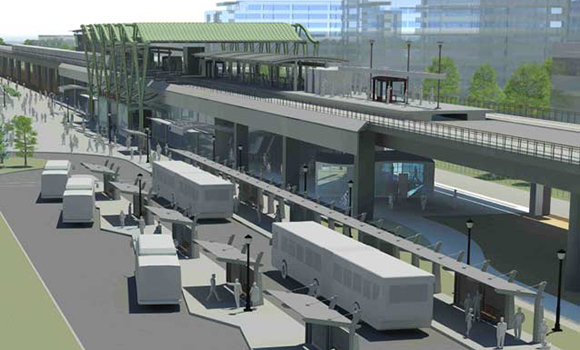
Rendering of Milpitas Station, part of VTA’s BART Silicon Valley Extension Phase I (Credit: VTA)
As part of a high-profile effort to provide local governments with more local economic development tools, the governor signed a package of bills yesterday that includes a major new expansion of local infrastructure financing authority supported by the California Economic Summit.
The bill, AB 313, authored by Speaker of the Assembly Toni Atkins, further enhances the powers of the Enhanced Infrastructure Financing Districts (EIFDs) created through legislation last year. This broad new authority allows cities, counties, and special districts eager to invest in infrastructure projects to jointly form public financing authorities with the power to direct an unprecedented array of funding streams—including the tax increment powers once used by redevelopment agencies—toward projects ranging from affordable housing and mixed-use developments to water systems and transit facilities.
In signing the bill, the governor approved several important changes to the statute—strengthening the relocation responsibilities of projects that displace existing residents, clarifying the process for how a district is formed, and ensuring that water and transit districts will be able to contribute resources and participate as full members of a district.
“This new authority has the potential to be one of the most significant innovations in public finance over the last decade in California, and all three of these changes will substantially increase the flexibility and funding capacity that can be brought to the table by these districts,” said Mark Pisano, co-lead of the Summit Infrastructure Action Team and professor of the practice of public administration at the USC Sol Price School of Public Policy. “There is no limit to the increase in value these districts can create with their investments, and now all of these resources can go back into communities to support other infrastructure and economic development.”
Since this new local authority was created last year, Summit partners have been highlighting how these new local financing powers can be used, as well as a range of projects that could benefit from them. A series of regional meetings hosted by the Southwest Megaregion Alliance and the Bay Area Council Economic Institute brought together interested infrastructure project proponents, local officials, and investors, and several cities are now making plans to use this authority. They include Los Angeles (as part of a $1 billion plan to restore the LA River), San Jose (to finance part of the $4 billion extension of BART into Silicon Valley), and Sacramento (to support a downtown revitalization effort that includes 10,000 new housing units).
Crafting an authority communities can rely on
While local leaders working with the Summit this year saw the potential in the new statute, they also noted several areas where it could be improved, working with the Speaker’s office to ensure they became part of AB 313.
This started with the law’s housing provisions, which were revised to make clear that an infrastructure district would not be able to remove or destroy homes as part of a public works project without complying with state laws regarding relocation assistance. (The new districts also have not been granted any powers of eminent domain.)
The process for forming a new district was also updated to ensure that an EIFD’s financing plan remained the responsibility of all of the agencies participating (including any number of cities, counties, and special districts)—and not just the city or county that forms the district.
“Both of these changes were aimed at keeping the needs of a districts’ residents front and center—and at ensuring this new authority encourages collaboration between governments. It’s about shared responsibility and shared resources: Whether you’re doing an environmental analysis or hiring a financing consultant to study a project, it will now be done by all of the entities jointly,” says Pisano. “This gives local governments the platform they need—but have never had before—to work across multiple jurisdictions to fund projects with a mix of public, private, and local resources.”
To ensure the new districts make the right investments, the right agencies also need to be involved. And in a June letter to the Speaker, the Summit called attention to a potential limitation in the statute that could prevent some local governments from participating. Because the law limited membership in an EIFD to agencies that received a share of the property tax, the Summit argued that this effectively excluded most water districts (which receive revenues from fees) and local transit districts (which receive a portion of locally-approved sales taxes).
“We saw that as a major obstacle, whether you’re a community that wants to use a new district to finance a stormwater capture system, an urban creek restoration project, or any combination of infill development, transit stations, and housing,” said Pisano.
The Santa Clara Valley Transit Authority, for example, which is funded by sales taxes, might have been prohibited from joining an EIFD with the City of San Jose and Santa Clara County to build an extension of BART into Silicon Valley. Water districts interested in working on multi-city stormwater capture systems would have faced the same issue.
“This is a statute with a lot of promise—as much promise as I’ve seen in my years working in public finance—and we wanted to make sure it could be effectively used to take on some of the state’s biggest challenges, whether it’s pollution or poverty or climate change,” said Pisano.
Working with the Speaker’s office, the Summit helped remedy all three of these issues. And now, with the governor’s signature, the new Enhanced Infrastructure Financing Districts can begin making the investments in infrastructure and economic development that California communities need.

